Protracted Storage for Calc-Alkaline Andesitic Magma in Magma Chambers: Perspective from the Nageng Andesite, East Kunlun Orogen, NW China
Abstract
1. Introduction
2. Geological Setting and Petrography
2.1. Geological Setting
2.2. Sampling and Petrography
3. Analytical Methods
3.1. Zircon U-Pb-Hf Isotope and Trace Element Analyses
3.2. Whole-Rock Major and Trace Element Analyses
3.3. Whole-Rock Sr-Nd-Pb Isotope Analyses
4. Results
4.1. Zircon U-Pb Ages and Trace Element Compositions
4.2. Whole-Rock Major and Trace Elements
4.3. Sr-Nd-Pb-Hf Isotope Data
4.4. Crystallization Temperature
5. Discussion
5.1. Magma Source
5.2. Magma Chamber Process
6. Conclusions
Supplementary Materials
Author Contributions
Funding
Data Availability Statement
Acknowledgments
Conflicts of Interest
References
- Grove, T.L.; Elkins-Tanton, L.T.; Parman, S.W.; Chatterjee, N.; Müntener, O.; Gaetani, G.A. Fractional Crystallization and Mantle-Melting Controls on Calc-Alkaline Differentiation Trends. Contrib. Mineral. Petrol. 2003, 145, 515–533. [Google Scholar] [CrossRef]
- Irvine, T.N.J.; Baragar, W.R.A. A Guide to the Chemical Classification of the Common Volcanic Rocks. Can. J. Earth Sci. 1971, 8, 523–548. [Google Scholar] [CrossRef]
- Miyashiro, A. Volcanic Rock Series in Island Arcs and Active Continental Margins. Am. J. Sci. 1974, 274, 321–355. [Google Scholar] [CrossRef]
- Tatsumi, Y.; Nakashima, T.; Tamura, Y. The Petrology and Geochemistry of Calc-Alkaline Andesites on Shodo-Shima Island, SW Japan. J. Petrol. 2002, 43, 3–16. [Google Scholar] [CrossRef]
- Zimmer, M.M.; Plank, T.; Hauri, E.H.; Yogodzinski, G.M.; Stelling, P.; Larsen, J.; Singer, B.; Jicha, B.; Mandeville, C.; Nye, C.J. The Role of Water in Generating the Calc-Alkaline Trend: New Volatile Data for Aleutian Magmas and a New Tholeiitic Index. J. Petrol. 2010, 51, 2411–2444. [Google Scholar] [CrossRef]
- Grove, T.L.; Till, C.B.; Krawczynski, M.J. The Role of H2O in Subduction Zone Magmatism. Annu. Rev. Earth Planet. Sci. 2012, 40, 413–439. [Google Scholar] [CrossRef]
- Kelemen, P.B.; Behn, M.D. Formation of Lower Continental Crust by Relamination of Buoyant Arc Lavas and Plutons. Nat. Geosci. 2016, 9, 197–205. [Google Scholar] [CrossRef]
- Chin, E.J.; Shimizu, K.; Bybee, G.M.; Erdman, M.E. On the Development of the Calc-Alkaline and Tholeiitic Magma Series: A Deep Crustal Cumulate Perspective. Earth Planet. Sci. Lett. 2018, 482, 277–287. [Google Scholar] [CrossRef]
- Hirose, K. Melting Experiments on Lherzolite KLB-1 under Hydrous Conditions and Generation of High-Magnesian Andesitic Melts. Geology 1997, 25, 42–44. [Google Scholar] [CrossRef]
- Sisson, T.W.; Grove, T.L. Experimental Investigations of the Role of H2O in Calc-Alkaline Differentiation and Subduction Zone Magmatism. Contrib. Mineral. Petrol. 1993, 113, 143–166. [Google Scholar] [CrossRef]
- Almeev, R.R.; Kimura, J.; Ariskin, A.A.; Ozerov, A. Decoding Crystal Fractionation in Calc-Alkaline Magmas from the Bezymianny Volcano (Kamchatka, Russia) Using Mineral and Bulk Rock Compositions. J. Volcanol. Geotherm. Res. 2013, 263, 141–171. [Google Scholar] [CrossRef]
- Ruprecht, P.; Bergantz, G.W.; Cooper, K.M.; Hildreth, W. The Crustal Magma Storage System of Volcán Quizapu, Chile, and the Effects of Magma Mixing on Magma Diversity. J. Pet. 2012, 53, 801–840. [Google Scholar] [CrossRef]
- Carmichael, I.S.E. The Redox States of Basic and Silicic Magmas: A Reflection of Their Source Regions? Contrib. Mineral. Petrol. 1991, 106, 129–141. [Google Scholar] [CrossRef]
- Grove, T.L.; Gerlach, D.C.; Sando, T.W. Origin of Calc-Alkaline Series Lavas at Medicine Lake Volcano by Fractionation, Assimilation and Mixing. Contr. Mineral. Petrol. 1982, 80, 160–182. [Google Scholar] [CrossRef]
- Cooper, K.M.; Kent, A.J.R. Rapid Remobilization of Magmatic Crystals Kept in Cold Storage. Nature 2014, 506, 480–483. [Google Scholar] [CrossRef] [PubMed]
- Szymanowski, D.; Wotzlaw, J.-F.; Ellis, B.S.; Bachmann, O.; Guillong, M.; von Quadt, A. Protracted Near-Solidus Storage and Pre-Eruptive Rejuvenation of Large Magma Reservoirs. Nat. Geosci. 2017, 10, 777–782. [Google Scholar] [CrossRef]
- Brown, S.J.A.; Fletcher, I.R. SHRIMP U-Pb Dating of the Preeruption Growth History of Zircons from the 340 Ka Whakamaru Ignimbrite, New Zealand: Evidence for >250 k.y. Magma Residence Times. Geology 1999, 27, 1035–1038. [Google Scholar] [CrossRef]
- Claiborne, L.L.; Miller, C.F.; Flanagan, D.M.; Clynne, M.A.; Wooden, J.L. Zircon Reveals Protracted Magma Storage and Recycling beneath Mount St. Helens. Geology 2010, 38, 511–531. [Google Scholar] [CrossRef]
- Kaiser, J.F.; de Silva, S.; Schmitt, A.K.; Economos, R.; Sunagua, M. Million-Year Melt–Presence in Monotonous Intermediate Magma for a Volcanic–Plutonic Assemblage in the Central Andes: Contrasting Histories of Crystal-Rich and Crystal-Poor Super-Sized Silicic Magmas. Earth Planet. Sci. Lett. 2017, 457, 73–86. [Google Scholar] [CrossRef]
- Reid, M.R.; Coath, C.D.; Mark Harrison, T.; McKeegan, K.D. Prolonged Residence Times for the Youngest Rhyolites Associated with Long Valley Caldera:230Th—238U Ion Microprobe Dating of Young Zircons. Earth Planet. Sci. Lett. 1997, 150, 27–39. [Google Scholar] [CrossRef]
- Dong, Y.; He, D.; Sun, S.; Liu, X.; Zhou, X.; Zhang, F.; Yang, Z.; Cheng, B.; Zhao, G.; Li, J. Subduction and Accretionary Tectonics of the East Kunlun Orogen, Western Segment of the Central China Orogenic System. Earth Sci. Rev. 2018, 186, 231–261. [Google Scholar] [CrossRef]
- Xiong, F.; Ma, C.; Jiang, H.; Liu, B.; Huang, J. Geochronology and Geochemistry of Middle Devonian Mafic Dykes in the East Kunlun Orogenic Belt, Northern Tibet Plateau: Implications for the Transition from Prototethys to Paleotethys Orogeny. Geochemistry 2014, 74, 225–235. [Google Scholar] [CrossRef]
- Huang, H.; Niu, Y.; Nowell, G.; Zhao, Z.; Yu, X.; Zhu, D.-C.; Mo, X.; Ding, S. Geochemical Constraints on the Petrogenesis of Granitoids in the East Kunlun Orogenic Belt, Northern Tibetan Plateau: Implications for Continental Crust Growth through Syn-Collisional Felsic Magmatism. Chem. Geol. 2014, 370, 1–18. [Google Scholar] [CrossRef]
- Li, X.; Huang, X.; Luo, M.; Dong, G.; Mo, X. Petrogenesis and Geodynamic Implications of the Mid-Triassic Lavas from East Kunlun, Northern Tibetan Plateau. J. Asian Earth Sci. 2015, 105, 32–47. [Google Scholar] [CrossRef]
- Shao, F.; Niu, Y.; Liu, Y.; Chen, S.; Kong, J.; Duan, M. Petrogenesis of Triassic Granitoids in the East Kunlun Orogenic Belt, Northern Tibetan Plateau and Their Tectonic Implications. Lithos 2017, 282–283, 33–44. [Google Scholar] [CrossRef]
- Xia, R.; Wang, C.; Qing, M.; Li, W.; Carranza, E.J.M.; Guo, X.; Ge, L.; Zeng, G. Zircon U–Pb Dating, Geochemistry and Sr–Nd–Pb–Hf–O Isotopes for the Nan’getan Granodiorites and Mafic Microgranular Enclaves in the East Kunlun Orogen: Record of Closure of the Paleo-Tethys. Lithos 2015, 234–235, 47–60. [Google Scholar] [CrossRef]
- Chen, X.D.; Li, Y.G.; Li, M.T.; Zhou, H.B.; Sun, C.B.; Zhao, Y.C.; Lai, C.K. Ore Geology, Fluid Inclusions, and C–H–O–S–Pb Isotopes of Nagengkangqieergou Ag-Polymetallic Deposit, East Kunlun Orogen, NW China. Geol. J. 2020, 55, 2572–2590. [Google Scholar] [CrossRef]
- Xianzheng, G.; Wanhong, X.; Hongbing, Z.; Chengsheng, T.; Jinchao, L.; Huilei, K.; Tao, Y.; Yao, X.G.; Xuegang, J. Zircon U-Pb Chronology and Geochemistry of the Rhyolite Porphyry in the Nagengkangqieer Silver Polymetallic Deposit, East Kunlun and Their Geological Significance. J. Earth Sci. 2019, 44, 2505–2518. [Google Scholar]
- Yang, T.; Zhou, H.B.; Zheng, Z.H.; Liu, H.; Li, J.; Li, M.T.; Zhang, L.; Li, Z.M.; Song, Z.B.; Zhang, B.; et al. Geological Characteristics and Genetic Type of the Nagengkangqieer Silver Polymetallic Deposit in East Kunlun. Northwest. Geol. 2017, 50, 186–199. [Google Scholar] [CrossRef]
- Liu, Y.; Gao, S.; Hu, Z.; Gao, C.; Zong, K.; Wang, D. Continental and Oceanic Crust Recycling-Induced Melt-Peridotite Interactions in the Trans-North China Orogen: U-Pb Dating, Hf Isotopes and Trace Elements in Zircons from Mantle Xenoliths. J. Petrol. 2010, 51, 537–571. [Google Scholar] [CrossRef]
- Liu, Y.; Zong, K.; Kelemen, P.B.; Gao, S. Geochemistry and Magmatic History of Eclogites and Ultramafic Rocks from the Chinese Continental Scientific Drill Hole: Subduction and Ultrahigh-Pressure Metamorphism of Lower Crustal Cumulates. Chem. Geol. 2008, 247, 133–153. [Google Scholar] [CrossRef]
- Ludwig, K.R. User’s Manual for Isoplot 3.00, a Geochronlogical Toolkit for Microsoft Excel; Berkeley Geochronology Center Special Publication: Berkeley, CA, USA, 2003; Volume 4, pp. 25–32. [Google Scholar]
- Wu, F.Y.; Yang, Y.H.; Xie, L.W.; Yang, J.H.; Xu, P. Hf Isotopic Compositions of the Standard Zircons and Baddeleyites Used in U–Pb Geochronology. Chem. Geol. 2006, 234, 105–126. [Google Scholar] [CrossRef]
- Liu, S.A.; Li, S.G.; He, Y.S.; Huang, F. Geochemical Contrasts between Early Cretaceous Ore-Bearing and Ore-Barren High-Mg Adakites in Central-Eastern China: Implications for Petrogenesis and Cu–Au Mineralization. Geochim. Cosmochim. Acta. 2010, 74, 7160–7178. [Google Scholar] [CrossRef]
- Blichert-Toft, J.; Chauvel, C.; Albarède, F. Separation of Hf and Lu for High-Precision Isotope Analysis of Rock Samples by Magnetic Sector-Multiple Collector ICP-MS. Contrib. Mineral. Petrol. 1997, 127, 248–260. [Google Scholar] [CrossRef]
- Scherer, E.; Münker, C.; Mezger, K. Calibration of the Lutetium-Hafnium Clock. Science 2001, 293, 683–687. [Google Scholar] [CrossRef]
- Griffin, W.L.; Belousova, E.A.; Shee, S.R.; Pearson, N.J.; O’Reilly, S.Y. Archean Crustal Evolution in the Northern Yilgarn Craton: U–Pb and Hf-Isotope Evidence from Detrital Zircons. Precambrian Res. 2004, 131, 231–282. [Google Scholar] [CrossRef]
- Ni, Z.Y.; Li, N.; Zhang, H.; Xue, L.W. Pb-Sr-Nd Isotope Constraints on the Ore-Forming Elements of the Dahu Au-Mo Deposit, Henan Province. Acta Petrol. Sin. 2009, 25, 2823–2832. [Google Scholar]
- Tanaka, T.; Togashi, S.; Kamioka, H.; Amakawa, H.; Kagami, H.; Hamamoto, T.; Yuhara, M.; Orihashi, Y.; Yoneda, S.; Shimizu, H.; et al. JNdi-1: A Neodymium Isotopic Reference in Consistency with LaJolla Neodymium. Chem. Geol. 2000, 168, 279–281. [Google Scholar] [CrossRef]
- Keto, L.S.; Jacobsen, S.B. Nd and Sr Isotopic Variations of Early Paleozoic Oceans. Earth Planet. Sci. Lett. 1987, 84, 27–41. [Google Scholar] [CrossRef]
- Belousova, E.; Griffin, W.; O’Reilly, S.Y.; Fisher, N. Igneous Zircon: Trace Element Composition as an Indicator of Source Rock Type. Contrib. Mineral. Petrol. 2002, 143, 602–622. [Google Scholar] [CrossRef]
- Le Bas, M.J.; Le Maitre, R.W.; Streckeisen, A.; Zanettin, B. IUGS Subcommission on the Systematics of Igneous Rocks. Chemical Classification of Volcanic Rock Based on the Total Alkali-Silica Diagram. J. Petrol. 1986, 745–750. [Google Scholar] [CrossRef]
- Peccerillo, A.; Taylor, S.R. Geochemistry of Eocene Calc-Alkaline Volcanic Rocks from the Kastamonu Area, Northern Turkey. Contrib. Mineral. Petrol. 1976, 58, 63–81. [Google Scholar] [CrossRef]
- Sun, S.S.; McDonough, W.F. Chemical and Isotopic Systematics of Oceanic Basalts: Implications for Mantle Composition and Processes. Geol. Soc. Lond. Spec. Publ. 1989, 42, 313–345. [Google Scholar] [CrossRef]
- Harnois, L. The CIW Index: A New Chemical Index of Weathering. Sedimen. Geol. 1988, 55, 319–322. [Google Scholar] [CrossRef]
- Ferry, J.M.; Watson, E.B. New Thermodynamic Models and Revised Calibrations for the Ti-in-Zircon and Zr-in-Rutile Thermometers. Contrib. Mineral. Petrol. 2007, 154, 429–437. [Google Scholar] [CrossRef]
- Claiborne, L.L.; Miller, C.F.; Wooden, J.L. Trace Element Composition of Igneous Zircon: A Thermal and Compositional Record of the Accumulation and Evolution of a Large Silicic Batholith, Spirit Mountain, Nevada. Contrib. Mineral. Petrol. 2010, 160, 511–531. [Google Scholar] [CrossRef]
- Watson, E.B.; Harrison, T.M. Zircon Thermometer Reveals Minimum Melting Conditions on Earliest Earth. Science 2005, 308, 841–844. [Google Scholar] [CrossRef] [PubMed]
- Chen, N.S.; Wang, X.Y.; Zhang, H.F.; Sun, M.; Li, X.Y.; Chen, Q. Geochemistry and Nd-Sr-Pb isotopic compositions of granitoids from Qaidam and Oulongbuluke micro-blocks, NW China: Constraints on basement nature and tectonic affinity. J. Earth Sci. 2007, 32, 7–21. [Google Scholar]
- Bian, Q.T.; Li, D.H.; Pospelov, I.; Yin, L.M.; Li, H.S.; Zhao, D.S.; Chang, C.F.; Luo, X.Q.; Gao, S.L.; Astrakhantsev, O.; et al. Age, Geochemistry and Tectonic Setting of Buqingshan Ophiolites, North Qinghai-Tibet Plateau, China. J. Asian Earth Sci. 2004, 23, 577–596. [Google Scholar] [CrossRef]
- Yu, N.; Jin, W.; Ge, W.C.; Long, X.P. Geochemical Study on Peraluminous Granite from Jinshuikou in East Kunlun. Glob. Geol. 2005, 24, 123–128. [Google Scholar]
- Liu, C.D.; Mo, X.X.; Luo, Z.H.; Yu, X.H.; Chen, H.W.; Li, S.W.; Zhao, X. Pb-Sr-Nd-O Isotope Characteristics of Granitoids in the East Kunlun Orogenic Belt. Acta Geos. Sin. 2003, 24, 584–588. [Google Scholar]
- Hu, Y.; Niu, Y.; Li, J.; Ye, L.; Kong, J.; Chen, S.; Zhang, Y.; Zhang, G. Petrogenesis and Tectonic Significance of the Late Triassic Mafic Dikes and Felsic Volcanic Rocks in the East Kunlun Orogenic Belt, Northern Tibet Plateau. Lithos 2016, 245, 205–222. [Google Scholar] [CrossRef]
- Liu, B.; Ma, C.Q.; Huang, J.; Wang, L.X.; Zhao, S.Q.; Yan, R.; Sun, Y.; Xiong, F.H. Petrogenesis and Tectonic Implications of Upper Triassic Appinite Dykes in the East Kunlun Orogenic Belt, Northern Tibetan Plateau. Lithos 2017, 284–285, 766–778. [Google Scholar] [CrossRef]
- Xiong, F.H.; Ma, C.Q.; Chen, B.; Ducea, M.N.; Hou, M.C.; Ni, S.J. Intermediate-Mafic Dikes in the East Kunlun Orogen, Northern Tibetan Plateau: A Window into Paleo-Arc Magma Feeding System. Lithos 2019, 340, 152–165. [Google Scholar] [CrossRef]
- Liu, B.; Ma, C.Q.; Zhang, J.Y.; Xiong, F.H.; Huang, J.; Jiang, H.A. 40Ar-39Ar Age and Geochemistry of Subduction-Related Mafic Dikes in Northern Tibet, China: Petrogenesis and Tectonic Implications. Int. Geol. Rev. 2014, 56, 57–73. [Google Scholar] [CrossRef]
- Xiong, F.H.; Ma, C.Q.; Zhang, J.Y.; Liu, B. LA-ICP-MS zircon U-Pb dating, elements and Sr-Nd-Hf isotope geochemistry of the Early Mesozoic mafic dyke swarms in East Kunlun orogenic belt. Acta Petrol. Sin. 2011, 27, 3350–3364. [Google Scholar]
- Ba, J.; Chen, N.S.; Wang, Q.Y.; Wang, X.Y.; Zhang, L.; Wang, S.Q. Nd-Sr-Pb Isotopic Compositions of Cordierite Granite on Southern Margin of the Qaidam Block, NW China, and Constraints on Its Petrogenesis, Tectonic Affinity of Source Region and Tectonic Implications. J. Earth Sci. 2012, 37, 80–92. [Google Scholar]
- Xiong, F.H.; Ma, C.Q.; Jiang, H.A.; Liu, B.; Zhang, J.Y.; Zhou, Q. Petrogenetic and Tectonic Significance of Permian Calc-Alkaline Lamprophyres, East Kunlun Orogenic Belt, Northern Qinghai-Tibet Plateau. Int. Geol. Rev. 2013, 55, 1817–1834. [Google Scholar] [CrossRef]
- Ballouard, C.; Massuyeau, M.; Elburg, M.A.; Tappe, S.; Viljoen, F.; Brandenburg, J.-T. The Magmatic and Magmatic-Hydrothermal Evolution of Felsic Igneous Rocks as Seen through Nb-Ta Geochemical Fractionation, with Implications for the Origins of Rare-Metal Mineralizations. Earth Sci. Rev. 2020, 203, 103115. [Google Scholar] [CrossRef]
- Claiborne, L.L.; Miller, C.F.; Walker, B.A.; Wooden, J.L.; Mazdab, F.K.; Bea, F. Tracking Magmatic Processes through Zr/Hf Ratios in Rocks and Hf and Ti Zoning in Zircons: An Example from the Spirit Mountain Batholith, Nevada. Mineral. Mag. 2006, 70, 517–543. [Google Scholar] [CrossRef]
- Deering, C.D.; Keller, B.; Schoene, B.; Bachmann, O.; Beane, R.; Ovtcharova, M. Zircon Record of the Plutonic-Volcanic Connection and Protracted Rhyolite Melt Evolution. Geology 2016, 44, 267–270. [Google Scholar] [CrossRef]
- He, D.; Dong, Y.; Zhang, F.; Yang, Z.; Sun, S.; Cheng, B.; Zhou, B.; Liu, X. The 1.0 Ga S–Type Granite in the East Kunlun Orogen, Northern Tibetan Plateau: Implications for the Meso– to Neoproterozoic Tectonic Evolution. J. Asian Earth Sci. 2016, 14. [Google Scholar] [CrossRef]
- He, D. Zircon U–Pb Geochronology and Hf Isotope of Granitoids in East Kunlun_ Implications for the Neoproterozoic Magmatism of Qaidam Block, Northern Tibetan Plateau. Precambrian Res. 2018, 17. [Google Scholar] [CrossRef]
- Xiong, F.H.; Ma, C.Q.; Zhang, J.Y.; Liu, B. The Origin of Mafic Microgranular Enclaves and Their Host Granodiorites from East Kunlun, Northern Qinghai-Tibet Plateau: Implications for Magma Mixing during Subduction of Paleo-Tethyan Lithosphere. Mineral. Petrol. 2012, 104, 211–224. [Google Scholar] [CrossRef]
- Tamura, Y.; Sato, T.; Fujiwara, T.; Kodaira, S.; Nichols, A. Advent of Continents: A New Hypothesis. Sci. Rep. 2016, 6, 33517. [Google Scholar] [CrossRef]
- Swinden, H.S.; Jenner, G.A.; Fryer, B.J.; Hertogen, J.; Roddick, J.C. Petrogenesis and Paleotectonic History of the Wild Bight Group, an Ordovician Rifted Island Arc in Central Newfoundland. Contrib. Mineral. Petrol. 1990, 105, 219–241. [Google Scholar] [CrossRef]
- White, W.M. Sources of Oceanic Basalts: Radiogenic Isotopie Evidence. Geology 1985, 13, 115–118. [Google Scholar] [CrossRef]
- Liu, B.; Ma, C.Q.; Zhang, J.Y.; Xiong, F.H.; Huang, J.; Jiang, H.A. Petrogenesis of Early Devonian intrusive rocks in the east part of Eastern Kunlun Orogen and implication for Early Paleozoic processes. Acta Petrol. Sin. 2012, 28, 1785–1807. [Google Scholar]
- Xia, R.; Wang, C.; Deng, J.; Carranza, E.J.M.; Li, W.; Qing, M. Crustal Thickening Prior to 220Ma in the East Kunlun Orogenic Belt: Insights from the Late Triassic Granitoids in the Xiao-Nuomuhong Pluton. J. Asian Earth Sci. 2014, 93, 193–210. [Google Scholar] [CrossRef]
- Zhang, J.Y.; Ma, C.Q.; Xiong, F.H.; Liu, B. Petrogenesis and Tectonic Significance of the Late Permian–Middle Triassic Calc-Alkaline Granites in the Balong Region, Eastern Kunlun Orogen, China. Geol. Mag. 2012, 149, 892–908. [Google Scholar] [CrossRef]
- Jiang, Y.H.; Jia, R.Y.; Liu, Z.; Liao, S.Y.; Zhao, P.; Zhou, Q. Origin of Middle Triassic High-K Calc-Alkaline Granitoids and Their Potassic Microgranular Enclaves from the Western Kunlun Orogen, Northwest China: A Record of the Closure of Paleo-Tethys. Lithos 2013, 156–159, 13–30. [Google Scholar] [CrossRef]
- Hawkesworth, C.J.; Mantovani, M.S.M.; Taylor, P.N.; Palacz, Z. Evidence from the Parana of South Brazil for a Continental Contribution to Dupal Basalts. Nature 1986, 322, 356–359. [Google Scholar] [CrossRef]
- Jackson, M.G.; Dasgupta, R. Compositions of HIMU, EM1, and EM2 from Global Trends between Radiogenic Isotopes and Major Elements in Ocean Island Basalts. Earth Planet. Sci. Lett. 2008, 276, 175–186. [Google Scholar] [CrossRef]
- Willbold, M.; Stracke, A. Formation of Enriched Mantle Components by Recycling of Upper and Lower Continental Crust. Chem. Geol. 2010, 276, 188–197. [Google Scholar] [CrossRef]
- Watson, E.B.; Harrison, T.M. Zircon Saturation Revisited: Temperature and Composition Effects in a Variety of Crustal Magma Types. Earth Planet. Sci. Lett. 1983, 64, 295–304. [Google Scholar] [CrossRef]
- Miller, J.S.; Matzel, J.E.P.; Miller, C.F.; Burgess, S.D.; Miller, R.B. Zircon Growth and Recycling during the Assembly of Large, Composite Arc Plutons. J. Volcanol. Geotherm. Res. 2007, 167, 282–299. [Google Scholar] [CrossRef]
- Corfu, F.; Hanchar, J.M.; Hoskin, P.W.O.; Kinny, P. Atlas of Zircon Textures. Rev. Mineral. Geochem. 2003, 53, 469–500. [Google Scholar] [CrossRef]
- Miller, J.S.; Wooden, J.L. Residence, Resorption and Recycling of Zircons in Devils Kitchen Rhyolite, Coso Volcanic Field, California. J. Petrol. 2004, 45, 2155–2170. [Google Scholar] [CrossRef]
- Campbell, I.H.; Ballard, J.R.; Palin, J.M.; Allen, C.; Faunes, A. U-Pb Zircon Geochronology of Granitic Rocks from the Chuquicamata-El Abra Porphyry Copper Belt of Northern Chile: Excimer Laser Ablation ICP-MS Analysis. Econ. Geol. 2006, 101, 1327–1344. [Google Scholar] [CrossRef]
- Siégel, C.; Bryan, S.E.; Allen, C.M.; Gust, D.A. Use and Abuse of Zircon-Based Thermometers: A Critical Review and a Recommended Approach to Identify Antecrystic Zircons. Earth Sci. Rev. 2018, 176, 87–116. [Google Scholar] [CrossRef]
- Crawford, A.J.; Falloon, T.J.; Eggins, S. The Origin of Island Arc High-Alumina Basalts. Contrib. Mineral. Petrol. 1987, 97, 417–430. [Google Scholar] [CrossRef]
- Sheth, H.C.; Torres-Alvarado, I.S.; Verma, S.P. What Is the "Calc-Alkaline Rock Series"? Int. Geol. Rev. 2002, 44, 686–701. [Google Scholar] [CrossRef]
- Myers, J.D.; Marsh, B.D.; Sinha, A.K. Geochemical and Strontium Isotopic Characteristics of Parental Aleutian Arc Magmas: Evidence from the Basaltic Lavas of Atka. Contrib. Mineral. Petrol. 1986, 94, 1–11. [Google Scholar] [CrossRef]
- Bachmann, O. On the Origin of Crystal-Poor Rhyolites: Extracted from Batholithic Crystal Mushes. J. Pet. 2004, 45, 1565–1582. [Google Scholar] [CrossRef]
- Hildreth, W. Volcanological Perspectives on Long Valley, Mammoth Mountain, and Mono Craters: Several Contiguous but Discrete Systems. J. Volcanol. Geotherm. Res. 2004, 136, 169–198. [Google Scholar] [CrossRef]
- Collins, W.J.; Murphy, J.B.; Johnson, T.E.; Huang, H.Q. Critical Role of Water in the Formation of Continental Crust. Nat. Geosci. 2020, 13, 331–338. [Google Scholar] [CrossRef]
- Jackson, M.D.; Blundy, J.; Sparks, R.S.J. Chemical Differentiation, Cold Storage and Remobilization of Magma in the Earth’s Crust. Nature 2018, 564, 405–409. [Google Scholar] [CrossRef]
- De Silva, S.L.; Gregg, P.M. Thermomechanical Feedbacks in Magmatic Systems: Implications for Growth, Longevity, and Evolution of Large Caldera-Forming Magma Reservoirs and Their Supereruptions. J. Volcanol. Geotherm. Res. 2014, 282, 77–91. [Google Scholar] [CrossRef]
- Wu, F.Y.; Liu, X.C.; Ji, W.Q.; Wang, J.M.; Yang, L. Highly fractionated granites: Recognition and research. Sci. China Earth Sci. 2017, 60, 1201–1219. [Google Scholar] [CrossRef]
- Bachmann, O.; Dungan, M.A.; Lipman, P.W. The Fish Canyon Magma Body, San Juan Volcanic Field, Colorado: Rejuvenation and Eruption of an Upper-Crustal Batholith. J. Petrol. 2002, 43, 1469–1503. [Google Scholar] [CrossRef]
- Chamberlain, K.J.; Wilson, C.J.N.; Wooden, J.L.; Charlier, B.L.A.; Ireland, T.R. New Perspectives on the Bishop Tuff from Zircon Textures, Ages and Trace Elements. J. Petrol. 2014, 55, 395–426. [Google Scholar] [CrossRef]
- Gagnevin, D.; Daly, J.S.; Kronz, A. Zircon Texture and Chemical Composition as a Guide to Magmatic Processes and Mixing in a Granitic Environment and Coeval Volcanic System. Contrib. Mineral. Petrol. 2010, 159, 579–596. [Google Scholar] [CrossRef]
- Li, R.; Pei, X.; Pei, L.; Li, Z.; Chen, G.; Chen, Y.; Liu, C.; Wang, M. The Early Triassic Andean-Type Halagatu Granitoids Pluton in the East Kunlun Orogen, Northern Tibet Plateau: Response to the Northward Subduction of the Paleo-Tethys Ocean. Gondwana Res. 2018, 62, 212–226. [Google Scholar] [CrossRef]
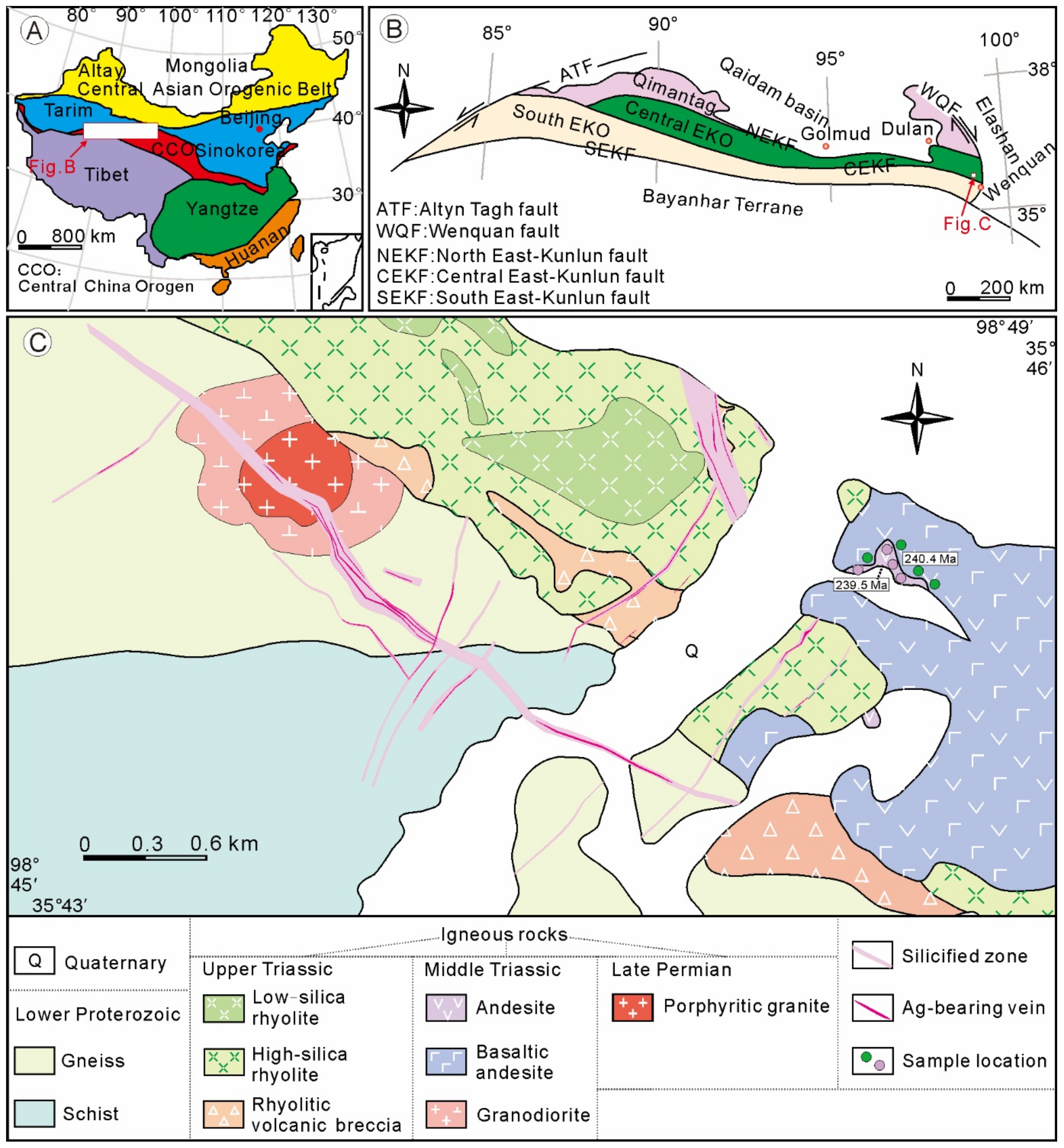

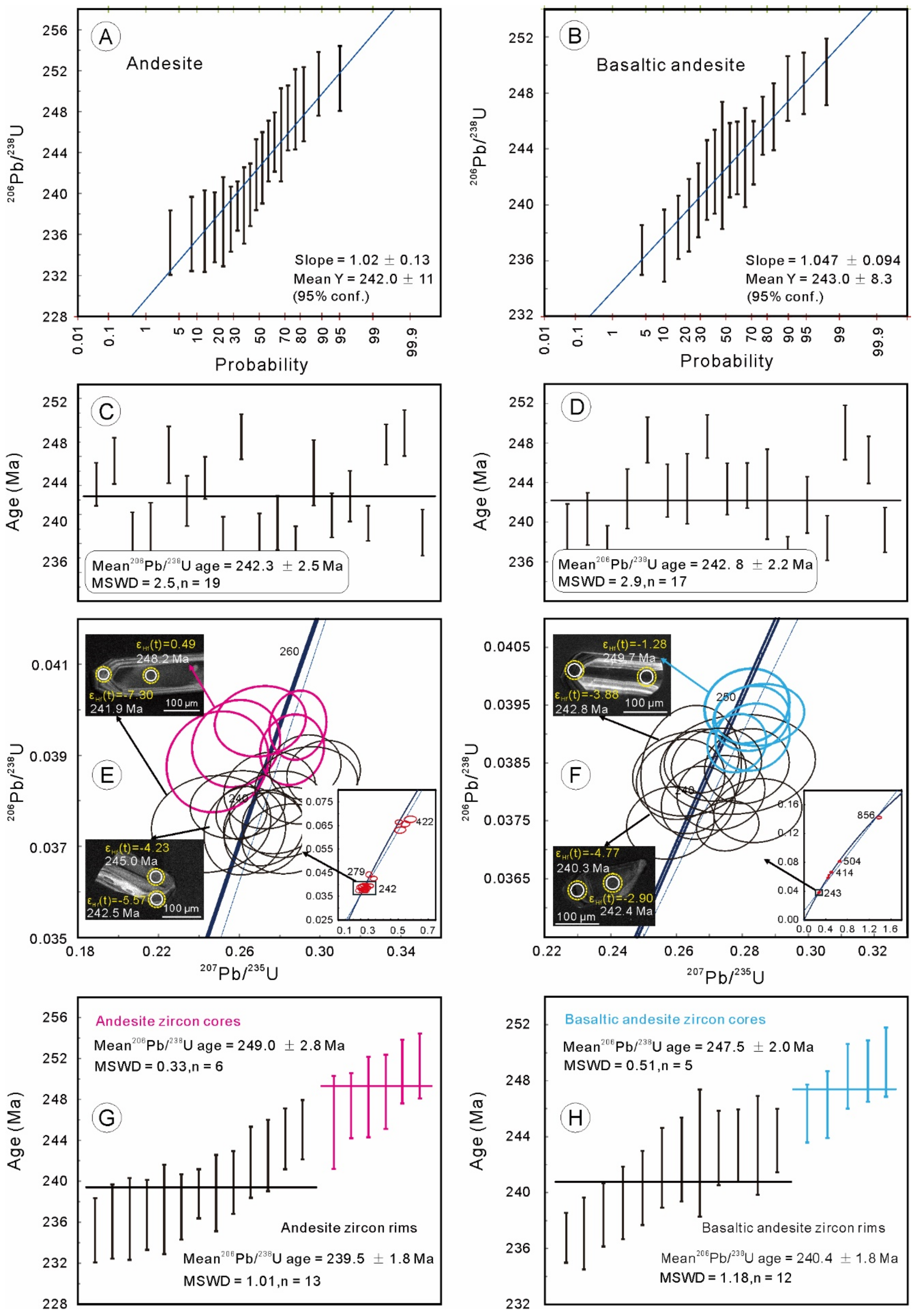
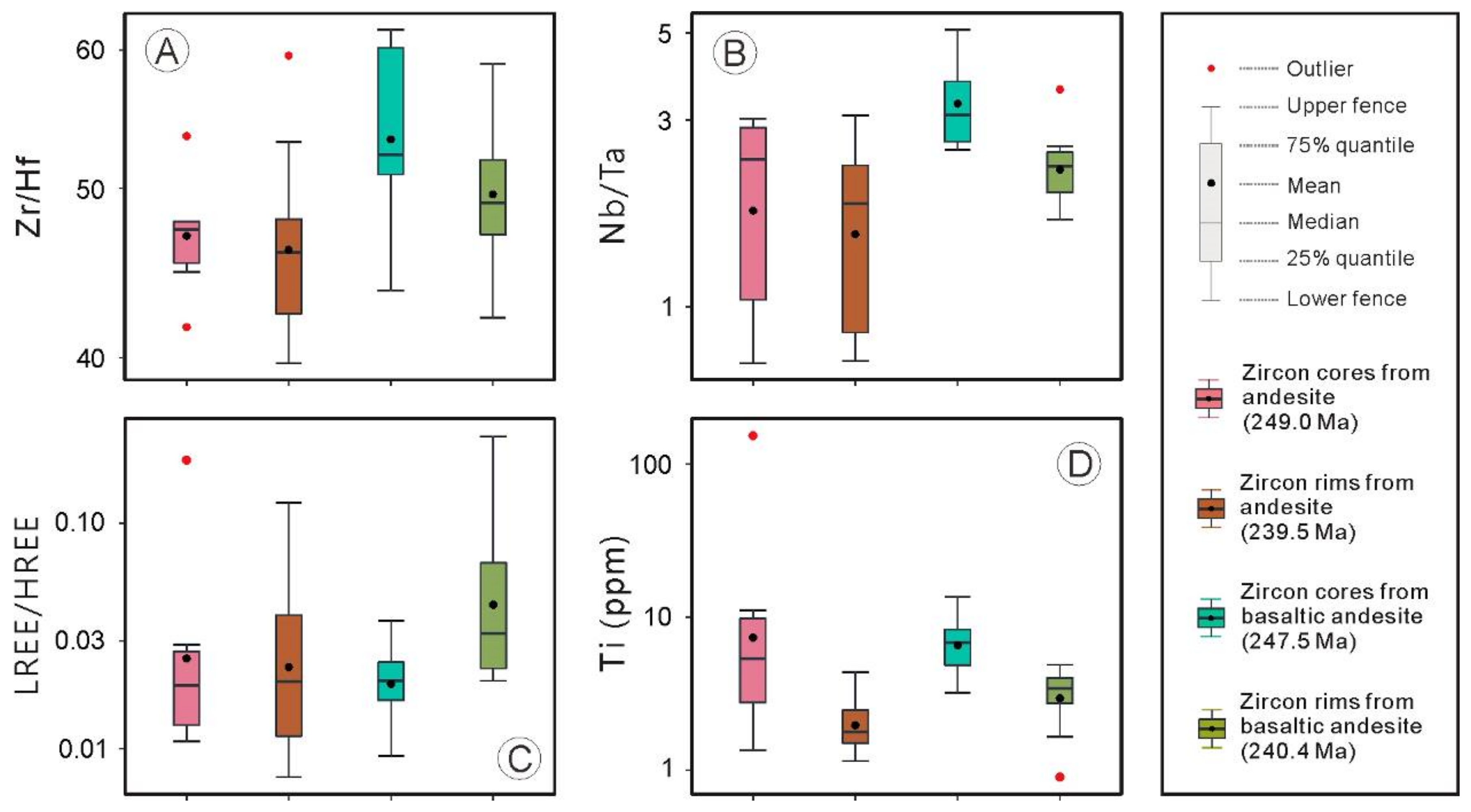
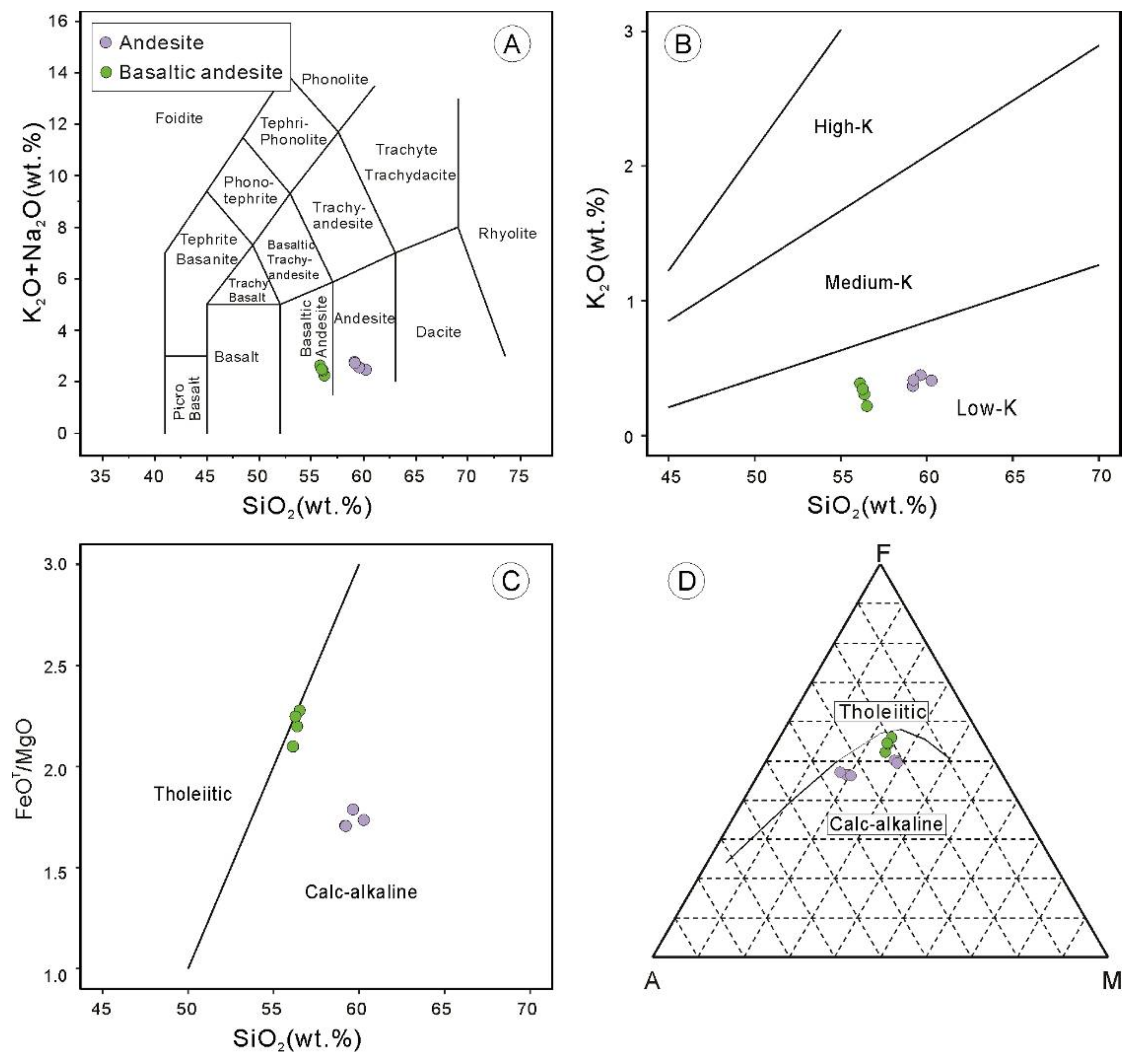
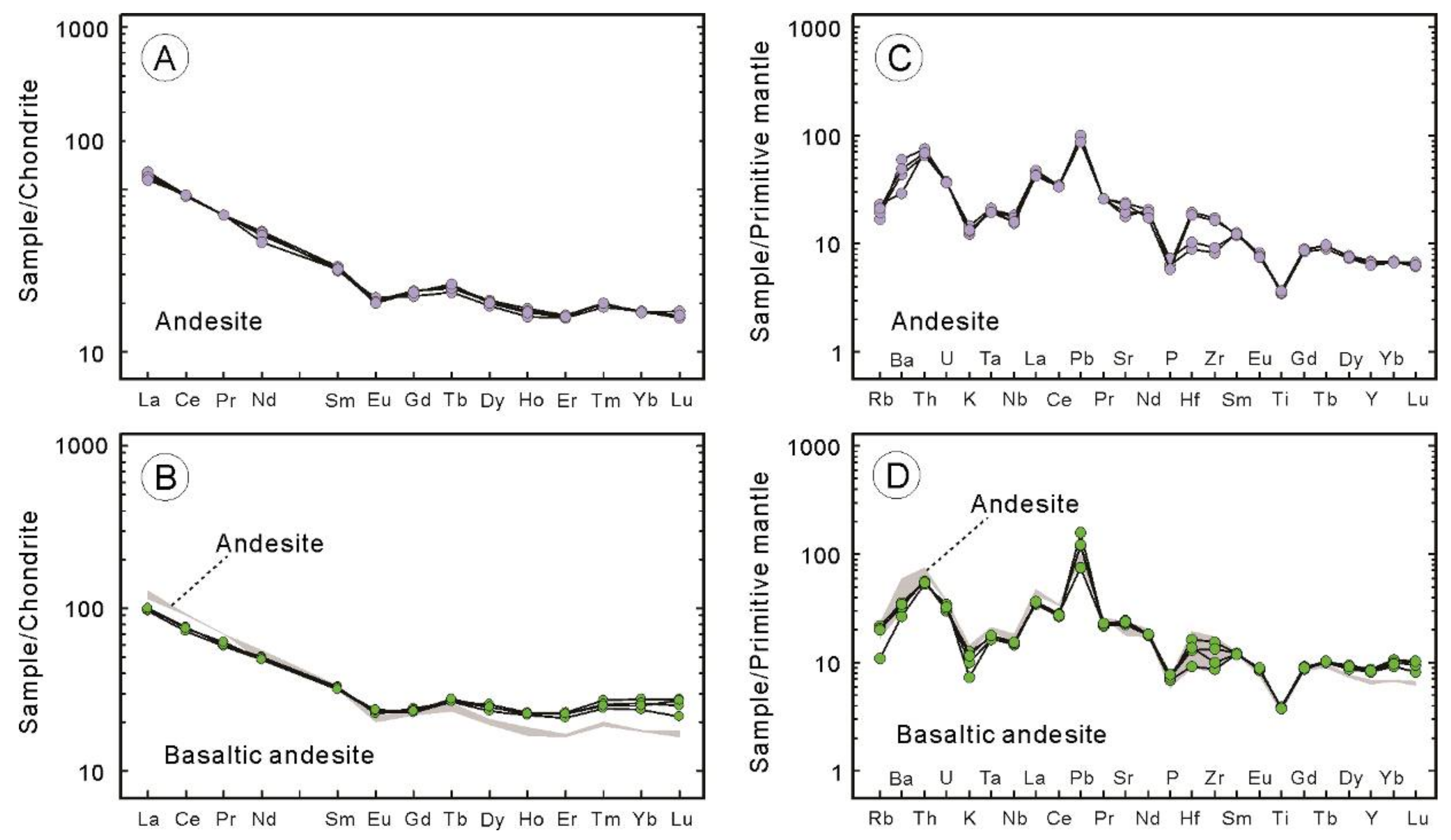
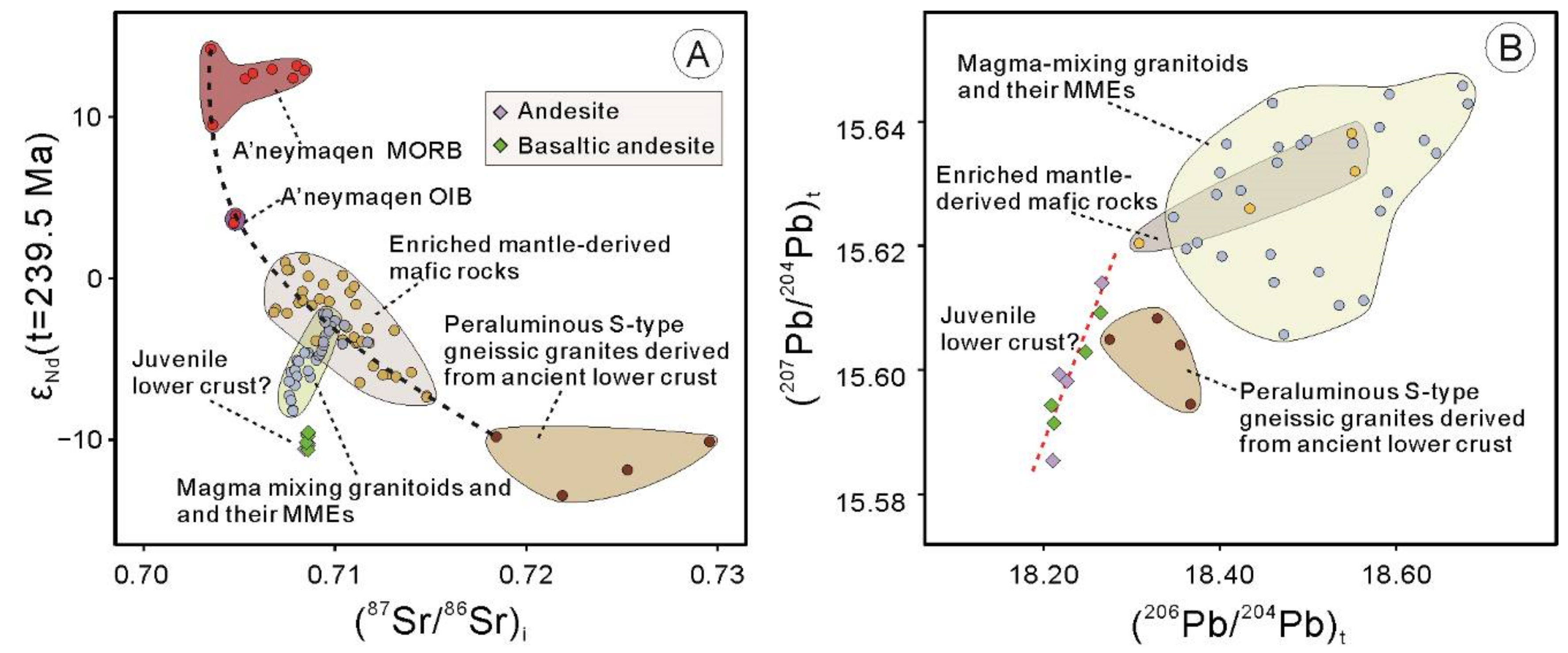

Publisher’s Note: MDPI stays neutral with regard to jurisdictional claims in published maps and institutional affiliations. |
© 2021 by the authors. Licensee MDPI, Basel, Switzerland. This article is an open access article distributed under the terms and conditions of the Creative Commons Attribution (CC BY) license (http://creativecommons.org/licenses/by/4.0/).
Share and Cite
Chen, X.-D.; Li, B.; Sun, C.-B.; Zhou, H.-B. Protracted Storage for Calc-Alkaline Andesitic Magma in Magma Chambers: Perspective from the Nageng Andesite, East Kunlun Orogen, NW China. Minerals 2021, 11, 198. https://doi.org/10.3390/min11020198
Chen X-D, Li B, Sun C-B, Zhou H-B. Protracted Storage for Calc-Alkaline Andesitic Magma in Magma Chambers: Perspective from the Nageng Andesite, East Kunlun Orogen, NW China. Minerals. 2021; 11(2):198. https://doi.org/10.3390/min11020198
Chicago/Turabian StyleChen, Xiao-Dong, Bin Li, Chong-Bo Sun, and Hong-Bing Zhou. 2021. "Protracted Storage for Calc-Alkaline Andesitic Magma in Magma Chambers: Perspective from the Nageng Andesite, East Kunlun Orogen, NW China" Minerals 11, no. 2: 198. https://doi.org/10.3390/min11020198
APA StyleChen, X.-D., Li, B., Sun, C.-B., & Zhou, H.-B. (2021). Protracted Storage for Calc-Alkaline Andesitic Magma in Magma Chambers: Perspective from the Nageng Andesite, East Kunlun Orogen, NW China. Minerals, 11(2), 198. https://doi.org/10.3390/min11020198




